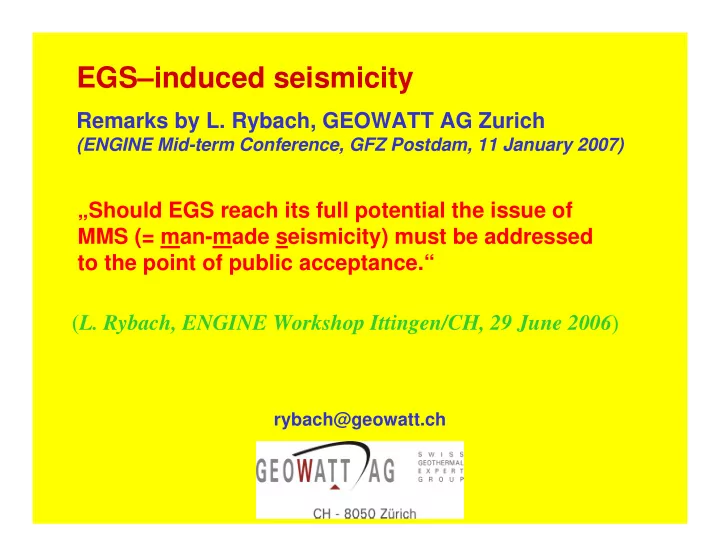

EGS–induced seismicity Remarks by L. Rybach, GEOWATT AG Zurich (ENGINE Mid-term Conference, GFZ Postdam, 11 January 2007) „Should EGS reach its full potential the issue of MMS (= man-made seismicity) must be addressed to the point of public acceptance.“ ( L. Rybach, ENGINE Workshop Ittingen/CH, 29 June 2006 ) rybach@geowatt.ch
The M = 3.4 event on 8 December 2006 in Basel/CH was not anticipated by the local population; the fear of a larger event which could follow led to the temporary stop of project operations. The largest MMS event experienced during EGS stimulation so far was a M = 3.7 event at Cooper Basin, Australia (on 5 December 2003, in an uninhabitated area). Events with M > 4.0 occur occasionally at The Geysers, due to continuous reinjection. Induced seismicity is also known from oil/gas production. Coal mining also led to earthquakes > 4.0.
Man-made earthquakes from various non-geothermal technologies Year Magnitude Location Technology 1983 6.5 Coalinga (CA USA) Oil production 1984 7.0 Gazli (Uzbekistan) Gas production 1989 5.6 Newcastle (NSW Australia) Coal mining 1993 6.1 Killary (SW India) Hydropower?
A whole series of M >3 events happened at Innamincka (Cooper Basin, Australia) in the first week of December 2003 Scopenergy ( 2004)
The IEA GIA Annex I / Subtask D WHITE PAPER (Majer et al. 2006) summarizes the present EGS-related MMS knowledge, identifies gaps, and indicates targets for R&D. Uploaded on www.iea-gia.org Additional issues to clarify have been added by L. Rybach (comments submitted to IEA GIA on 14 November 2006), see below:
1. Search for means to discriminate EGS-related MMS from natural seismic events: Identify and characterize attributes typical of EGS-caused events (duration, sound, frequency content, dominant frequency....) 2. Looking into possible seismic effects during long-term EGS operation (production phase): Can it be expected that the level of seismicity due to production will be lower than that during stimulation? So far there is no (or not much) experience about thermoelastic effects (cooling cracks) on the long term. 3. How far can relevant stress field pertubations reach out from EGS operations? Pore pressure build-up propagates generally quickly but reduces with distance. 4. Related to the above issue: What safety distance is needed between an EGS reservoir and a nearby ”capable fault”? (The planned reservoir of the DHM project in Basel would be located ~ 2 km west of the major listric Eastern Boundary Fault of the Rhine Graben)
5. Substantiation and generalization (if possible) of the findings of Italian researchers in Tuscany (Barbier 1997): • increasing volumes of reinjected fluids do not lead to larger earthquakes, but to more frequent events; • reinjection has possibly a positive effect, by releasing stress in numerous smaller events, which acts against stress accumulation for a large single earthquake. 6. Further studies on post shut-in seismicity: MMS could happen after a production stop implemented according to the “Traffic light” concept.
The IEA GIA Annex I / Subtask D PROTOCOL (Baria & Majer 2006) addresses the issues of public awareness and acceptance; it suggests steps to be undertaken to reach these ambitious goals. Uploaded on www.iea-gia.org Additional issues to clarify have been added by L. Rybach (comments submitted to IEA GIA on 14 November 2006); An excerpt follows:
The Protocol’s main handling and action scheme (=steps) remains reactive. It suggests measures like those included in the ”Traffic light” action plan, which can only be implemented after a seismic event has already happened. What would really be needed is a procedure to prevent –or at least reduce– future, disturbing (M ≥ 3) seismic events related to EGS operations. Public perception is equally important and can be crucial. Fears and expectations must be taken serious (e.g the fear that small but repeated MMS could accumulate energy in the ground and trigger –earlier than by nature– a large seismic event). Therefore constant, transparent and unbiased information is indispensable in order to achieve pubic acceptance as far as possible.
Still a lot remains to be done. EGS development must proceed in parallel with basic research on EGS-induced seismicity (for open questions and corresponding investigations see the ”White paper”). It will be crucial to have firm ground for MMS handling and EGS project management before a significant number of EGS systems goes into production.
The crucial problem to solve is: (Analogy: „How to wash the bear without wetting his skin“) How to create a suitable EGS reservoir (by fracture opening/shearing) without undesired ground shaking ( � “ soft stimulation“? ).
The bottom line: It is now up to ENGINE (several Work Packages) to become active in the problems of noticable, EGS-related ground shaking. WP 1 Project management WP 2 Information and dissemination system WP 3 Investigation of Unconventional Geothermal Resources and EGS WP 4 Drilling, stimulation and reservoir assessment WP 5 Exploitation, economic, environmental and social impacts WP6 Expertise on investigation of unconventional Geothermal resources and EGS WP7 Expertise on drilling, stimulation and reservoir assessment WP8 Expertise on exploitation, economic, environmental and social impacts WP9 Risk evaluation for the development of geothermal energy
Recommend
More recommend